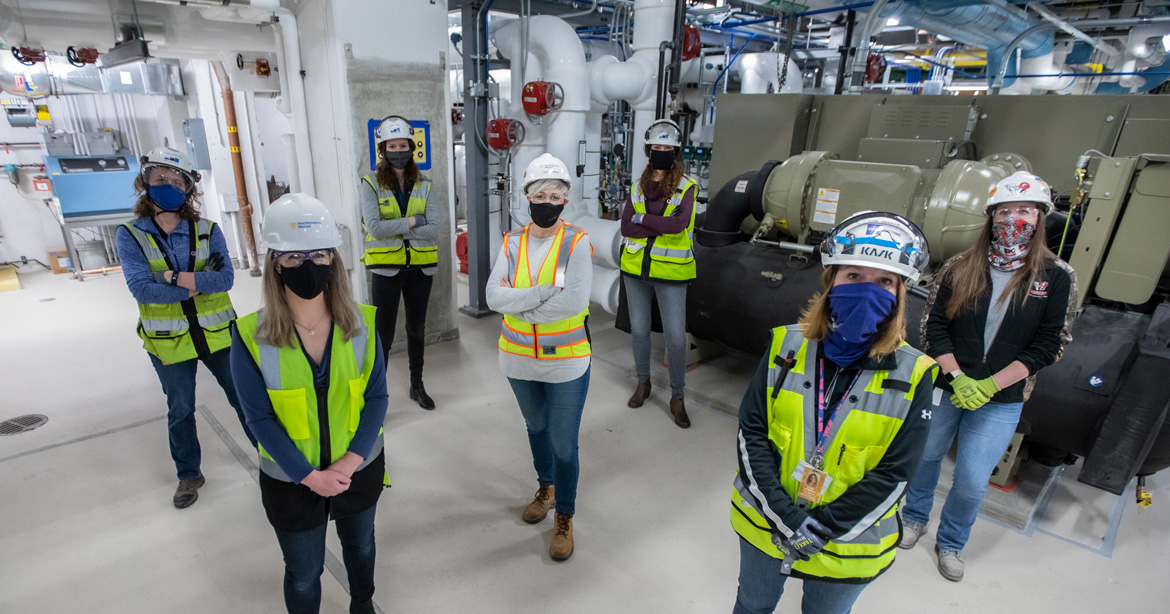
Add face coverings to the long list of personal protective equipment (PPE) worn on a jobsite: hardhats, safety glasses, visors, gloves, boots, safety vests…. It’s not easy to distinguish who’s who out in the field. Historically, those construction crews are comprised primarily of men, having grown to a mere 10.3% of all people working in construction being women. Even smaller is the number of women on the front lines of a construction jobsite – only one out of every 100 employees in the field.
At first glance, the Mortenson team leading the Northwestern Mutual Data Center projects right here in Milwaukee doesn’t look unique… A team of people suited in full PPE, equipped with the latest tools and technologies, and consistently demonstrating their hard work ethic and passion for construction.
It’s only when you return to the jobsite trailers do you realize this team is comprised primarily of women.
This particular project brings an even higher level of complexity in that the team is responsible for consolidating and updating the data centers that house precious data for the Fortune 500 company.
The project, which began design in 2019, consists of the modernization of two data center sites – one of which was relocated from a different floor within the building into a new architectural design and layout. It included assessing and replacing all MEP equipment, and ensuring the latest state-of-the-art security measures.
The larger 21,639-square-foot data center’s infrastructure was modernized to support a long-term sustained system and the integrity of applications. The goal is to achieve power and cooling capacity at either data center location to support disaster recovery. Modernization of both data centers will align with Tier III quality standards, ensuring IT components are powered with multiple, active and independent sources of power and cooling resources. A Tier III data center can perform repairs without any notable service disruption.
There are many design and construction projects where there is one woman sitting at the table – but it is quite unique when the majority of the project leaders are women. This is also more notable when it’s such a technical project type, and one that was completed within existing facilities that remained active throughout construction – not to mention amongst an unprecedented pandemic.
The women taking seats at this project’s table encompass all different levels of project management and execution, and with a variety of firms including the owner, designer, contractor, and trade partners. They range from project managers, superintendents, drywall carpenters, electricians, laborers, mechanical engineers, estimators, designers, and safety professionals.

“I remember being the only female assistant project manager when I started my career 25 years ago,” says Northwestern Mutual’s leader of Workplace & Project Solutions, Tracy Lutterman. “The women I know in construction, then and now, including those on this project, are tenacious, fearless and determined.”
Lutterman leads the team that specializes in space planning, architecture, interior design, building improvements, art, and furniture. Her team consists of 13 members and a portfolio of over 3.5 million square feet in Milwaukee, Franklin, and New York.
Integral to the project’s planning and execution on Northwestern Mutual’s side is also Christine Bertolotto, Systems and Facilities Project Manager. She served as liaison to the owner’s IT team, leading the early planning efforts of working through the project’s scope, and securing approvals for work throughout various required shutdowns and testing requests.
“It’s true that our project team was unique in the sense that we had a strong representation of women leading the project, but more importantly the full team dynamic was that of mutual respect and collaboration,” she says. “Persons at all levels of experience were at the table to weigh-in on design decisions. Never have our teams been engaged so early on helping make decisions about design and constructability. We all engaged together to create a very healthy team dynamic with more collaboration, less hand-offs, and better decision-making.”
Planning for a phased construction and turnover of two separate project sites that were both to remain operational took a high level of collaboration and commitment by all parties involved. For Northwestern Mutual, this meant carefully choosing the right participants needed to achieve unified buy-in. The team took time together early on to clearly establish goals, expectations, and agree on responsibilities.
A key part of that collaborative alignment was managed by Mortenson’s Design Phase Manager Katherine Hitch. She worked to balance the project’s scope with the budget throughout the planning and design process. She coordinated with varying team members to establish realistic and achievable schedule milestones, and managed the arduous permitting process.
“Having the MEP early trade partners at the table with us throughout the design and planning process of this technically complex project was essential,” says Hitch.
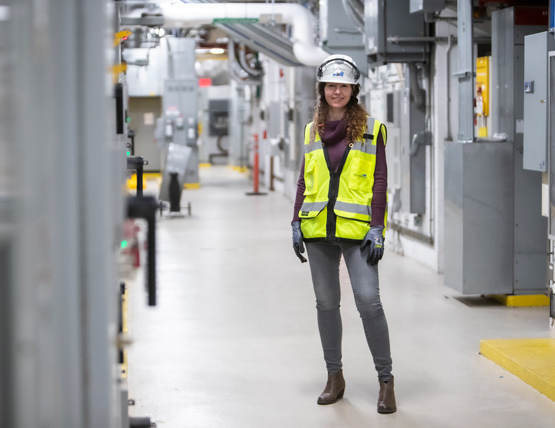
Laura Rudolph, Senior MEP Project Manager with Mortenson has also proven to be an invaluable member of the team from early planning efforts well into on-site construction. Her technical expertise covers cost estimating, precise scheduling, MEP systems selection, and installation and commissioning activities.

“I was one of a handful of females in my engineering studies,” says Rudolph, a graduate of Milwaukee School of Engineering. “I’ve always enjoyed working on technically complex projects.”
Rudolph lent her MEP-focused commissioning expertise to the tail end of projects for years, before moving into a more holistic role of managing projects from start to finish.
“Bringing a team together to achieve something we couldn’t have solved on our own is one of the most rewarding parts of what I do,” Rudolph says. “The very early partnerships with the designers and trade partners who brought their individual expertise really set the tone for this project.”
“We all brought our expertise to the table. We maintained open communication and built upon our foundation of trust and respect to work through design considerations, sequencing changes, and testing challenges. With each challenge, our team grew more efficient and worked through issues faster.”
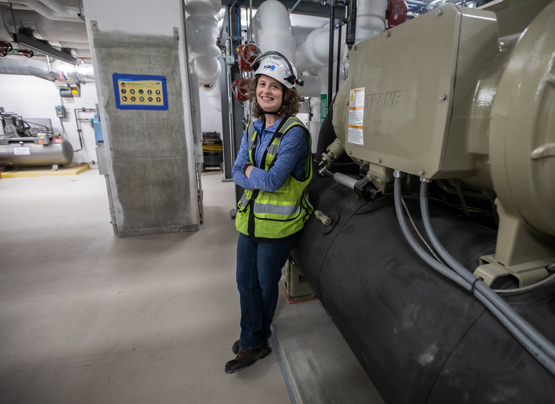
Obviously, this project required substantial technical planning and design. So, how did those complex specs get translated once in the field? Enter Mortenson’s Superintendent Alice Westphal, a 22-year construction veteran with a specialized background in MEP coordination. As site superintendent, Alice assesses if design elements are constructable in the field, manages the logistics of the jobsite, and ensures all work is put in place at the highest quality – and safely – each and every day.
“This project provided an opportunity for early partnership of Owner, Builder, Designer, and Specialty Trade Partner,” says Westphal, “and as a result, we were able to build a collaborative team which allowed us to overcome technical design and installation challenges, understand existing condition issues, and maintain safe work environments – all during a pandemic.”
While the data center modernization process was heavily driven by MEP considerations, it was necessary for the team to coordinate with the existing structure to accommodate the new buildout. The project required opening up the building’s existing structure to allow for the removal of old equipment and bringing in new equipment to the lower level mechanical spaces. The opening allowed movement of materials 34 feet below grade from the building’s active loading dock – another strategic challenge the project team needed to overcome. Considering Wisconsin’s unpredictable weather, and the long-lead nature of the project, the team had to design and build a temporary watertight cover to protect the structural opening over the existing electrical equipment for six months.
Westphal believes the most challenging aspects of this project were also the most satisfying. “We mobilized on March 30, 2020 during Wisconsin’s Safer at Home order. The early safety planning became even more important to the success of our project. In addition to construction activity, we were also learning how to establish safe work plans for crews which included spatial distancing, face coverings, and additional occupational health considerations.”
“I enjoy being involved in challenging projects,” says Westphal, “I now understand the right team can overcome the most overwhelming of challenges – and that the truly rewarding role as a leader is to build the team which works together to overcome technical challenges.”
A critical part of a project with such specialized electrical work is not only keeping everyone safe, but also facilitating a culture of safety on every level. Lynn Anderson, Senior Site Safety & Health Specialist with Staff Electric Company, engaged with the workforce to ensure safety planning was implemented.
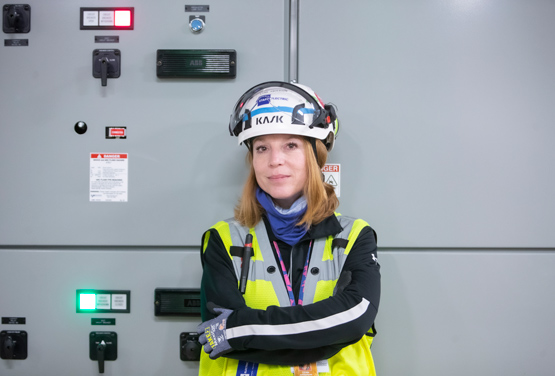
Everyone onsite embraced an exceptional safety attitude and perspective. Crews embraced the need for extra safety documentation, and enthusiastically adopted the Safety Incentive Program.
“This is one of a few projects where I was able to work more closely with our general contractor and I have a new appreciation for the guidance and support of teams like this.” Construction required more than 60 Integrated Work Plans (IWPs), which are detailed work instructions for safe work practices on specific scopes of work like crane picks or electrical shutdowns. These IWPs were spread between both sites and all crews.
“Each specialized crew kept me on my toes… We started with the electrical crew, then the technology crew, on the tail end came the Building Automation System (BAS) crew, and let’s not forget the medium voltage crew as well,” says Anderson. “The best part of working with all of the separate crews was watching them work together.”
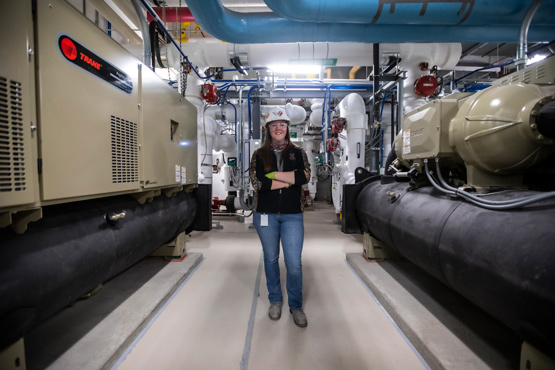
The mechanical team had their work cut out for them on this project. Melissa McFadden, Project Manager with Grunau Company, led the mechanical pipe, sheet metal, and controls team. McFadden had an extremely hands-on approach to this project.
“One of the things I enjoy most about my job is being able to get “into the weeds” of a project, especially one that’s as mechanically focused as this one. It was extremely rewarding to be part of the design and planning on this project, and then lead our team through the execution.”
She’s a detailed planner who has been instrumental in the commissioning process, a process that can bring stress and disruption if not planned well, especially within a technologically complex data center.
“One of my biggest takeaways is how big of an impact the project team can have on the success of a project, says McFadden. “All levels of leadership brought their own experience, expertise, and contributions. Whether it was a pipefitter apprentice voicing his opinion about a safety topic or a senior executive providing input on the design, everyone was able to positively influence this project in their own way.”
It is no doubt that construction continues to be a male-dominated industry. When everyone looks similar, it’s difficult for women to recognize where they may fit in. This project team, although a current anomaly, is proof that Women in Construction are the future of building.
“We don’t let our gender diminish the passion we have for construction, nor stifle our humility to learn,” says Tracy Lutterman. “That gives us power.”
Women in Construction (WIC) Week is celebrated March 7-13, 2021
The theme of WIC Week 2021 is Connect-Collaborate-Construct
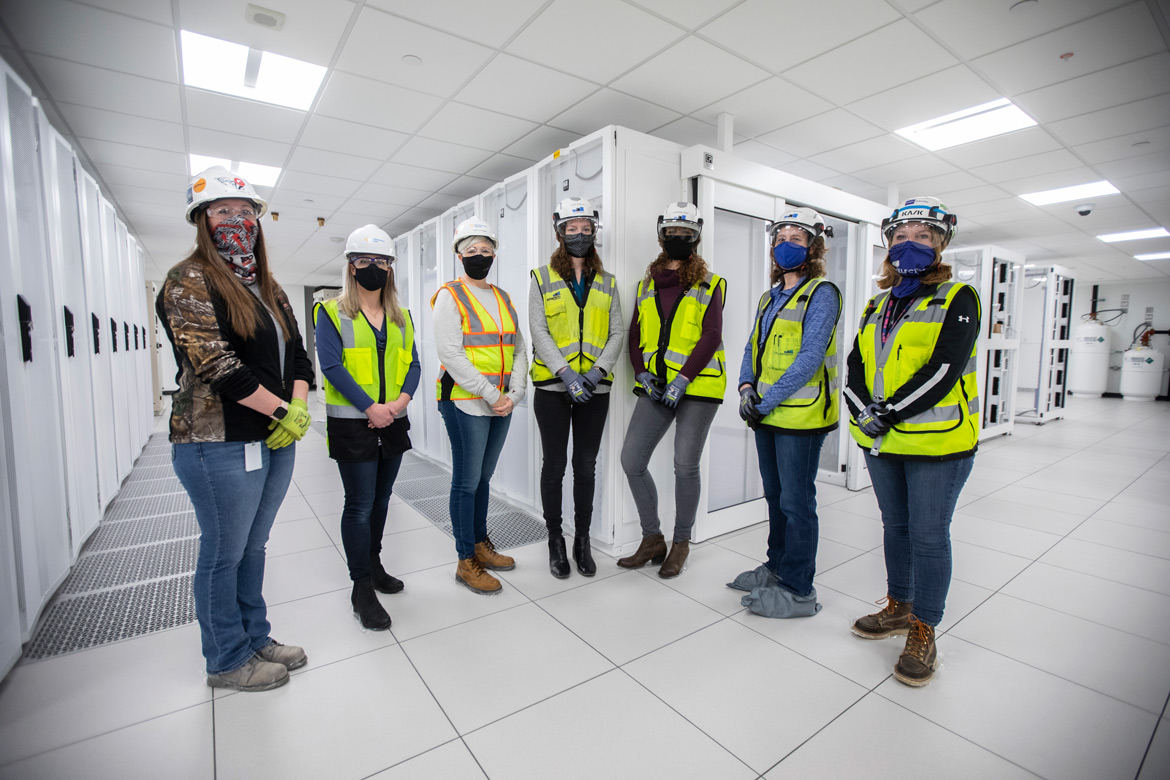
With more than 115 chapters across the country, the National Association of Women in Construction (NAWIC) is celebrating Women in Construction (WIC) Week on March 7-13. The focus of the week is to highlight women as a viable component of the construction industry including women builders in the trades, project management, marketing, administration, executive leadership, and more. WIC Week provides an occasion for NAWIC’s thousands of members across the country to raise awareness of the opportunities available for women in the construction industry and to emphasize the growing role of women in the industry. NAWIC offers its members education, support and networking to help advance their careers in construction, build their technical skills, grow as individuals, and become some of the most accomplished leaders in our profession.